Introduction
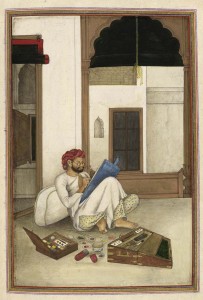
The period of Delhi Residency is a twilight zone between the Mughal emperors and British crown. This was the time period when East India Company captured Delhi from Marathas and appointed a head called “Resident” for administration. By this time, Delhi’s old masters the Mughals have been reduced to a husk, a subordinate position, due to several raids and defeats. Bishop Heber writes about Diwan-i-Am, “The spider hath woven his web in the Royal Palace of Caesars. The owl standeth sentinel in the watch towers of Afrasiab.”
The Whites however knew about the grandeur of Mughal culture from earlier works of Travelers and company officials and were curious about those exotic times. Their curiosity became the reason for revival of court culture including royal patronage to paintings but under English banner. The beginning of colonial rule is a very crucial era in India’s history. This study of paintings under this particular reign becomes even more crucial because it tells us about socio-cultural aspect of a rapidly changing society. It shows the perspective of a group of people and lifestyle in that environment even if that is from the point of view of elites.
The Residents
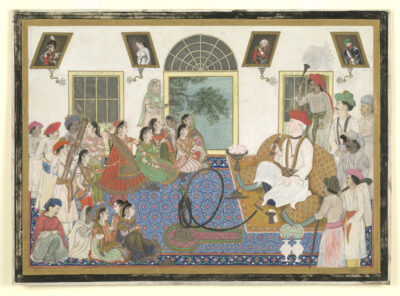
The artisans were being funded by Company officials and Residents, the first Resident of Delhi was David Ochterlony. He had quite a fascination with the Mughal culture of that era. He was given the title of Nasir-ud Daula by contemporary Mughal ruler Shah Alam. His lifestyle itself was like a Mughal Emperor filled with Indian attires, huqqah, and dance girls. The works of Bishop Reginald Heber, that accompanied him tells us about how he was always visible in Indian pajamas, turbans, and servants with peacock feathered fans. He also talked about how Ochterlony used to have evening walks on elephant with his thirteen Indian wives.
His successors were no different, being equally impressed by the culture. William Fraser, the next Resident, was even a Persian scholar, commissioning the most important artistic creation of that time ‘The Fraser Album’. His lifestyle was similar with local habits and manners of nobility. When Lady Nugent, wife of Commander-in-Chief of East India Company met Ochterlony, Fraser and another official named Edward Gardener, she was appalled by their native habits. She complained to higher ups, how they have grown beards, given up on eating beef or pork and became “Indoo” forsaking Christianity.
Safe to say that complaint worked and these officials were replaced by a British hardliner Thomas Metcalfe, whose only task was to completely remove the Mughal rule. Ironically, after some years even he commissioned a masterpiece of album The Delhie Book.
It is of no surprise that these officials revived, retained and reformed the imperial painting tradition.
Motive and Artisans
The Indian paintings were actually in high demand among European societies as previously thought. They wanted to see this exotic world complete with local lifestyles, architecture, flora and fauna. Artists of this time, due to the decline in Royal Atelier, created for general sale, contemporary rulers, and British patrons. Some of the most famous painters of this time are Lalji, Jivan Ram, Mazhar Ali Khan, Ghulam Ali Khan, and Ghulam Murtaza Khan.
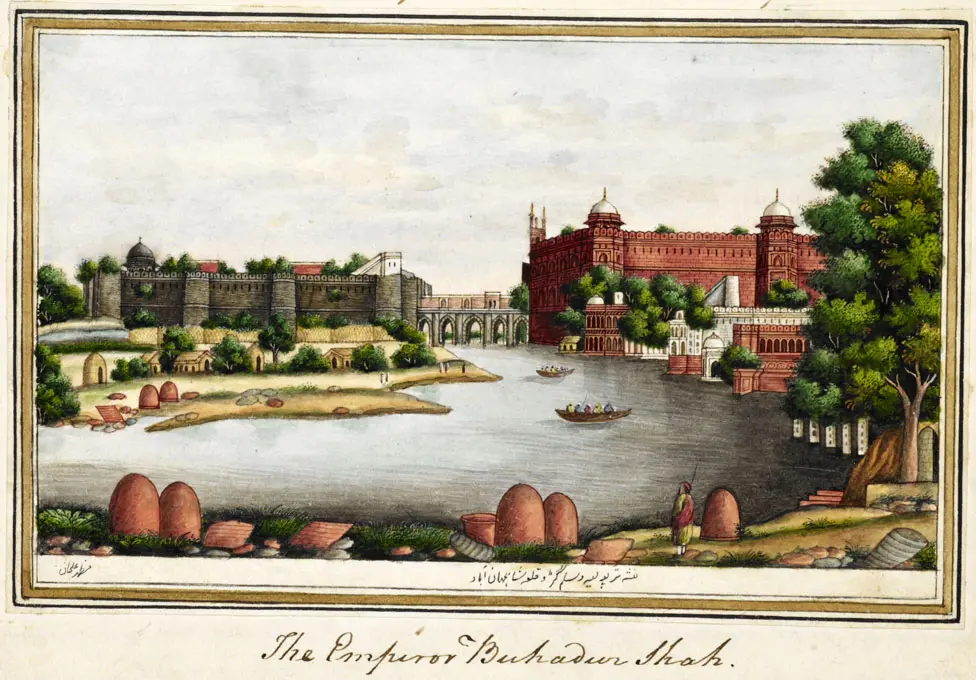
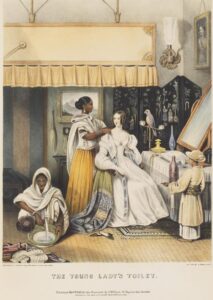
These artists being trained in Indian schools of art combined miniature painting style with European realism to suit their masters. They used large English papers with pen and ink to draw. They generally used cream and grey for softness and gold, red, and green for immersion. It also showcases the intricate detailing that Indian painters loved in miniature paintings. But unlike the traditional perspective of miniatures, they used European method with plain backgrounds elevated buildings with black borders.
The attitude was much different for European painters of that era like Thomas and William Daniell, William Hodges, etc. These paintings are the perception of British officials to show ordinary British citizens. It can be rather diminishing in representation of Indian lifestyle. One example being, diverse portrayal of skin complexities by Indian painters but much darker complexity used by British one. According to art historian Swati Chattopadhyay, the Daniells would include their servants not on-site but later fitting them into scenery, not as respected individuals but as decorations, symbol for Empire’s growth.
Motifs and Themes
The general motifs and themes were dependent on the liking of English patrons. Those seeking for exotic arts and styles and to look at newly annexed territories were in high demand. Thus, this period generally showcased architecture, court life, common life and flora and fauna.
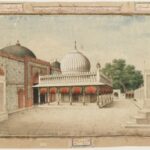
Architecture: It includes picturesque landscapes, views of cities and monuments alien to British. Several works spanning across even more several volumes were done on almost all of the architecture i.e. Red Fort, Jama Masjid, Qutb Minar, Firuz Shah Kotla, Tughlakabad, Tombs of Safdarjung and Humayun etc.
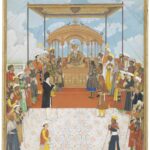
Court Life: British officials were most excited about the courtly culture filled with all the golden luxuries, harems, and nautch (dance) girls. Their durbars, workings and processions with elephants and trumpeters, also became the subject of paintings.
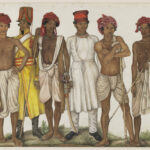
Common Life: The citizens back in England were especially curious about the Indian manners, customs and habits. Indian painting tradition usually revolved around ruler and religion but with the change the common people were depicted for the first time. Vastly different occupations like musicians, dancers, bird catchers, opium dealers, ironsmiths, ministers, tax collectors and even the artists themselves were being depicted.

Natural History: This was the curiosity of intellectual mind of Europe, to see the images of different flora and fauna not available in their continent. They were delighted to encounter new species and botanical studies, sometimes these images even constituted as the largest part of volumes and albums.
Decline and Current status
After the 1857 revolution and passing of control to British crown, this prestige was systematically destroyed. The Royal court was completely wrecked indirectly disbanding professions related to court culture like music, dance and paintings. Monuments like tombs and forts became offices and military camps, later being preserved for tourism.
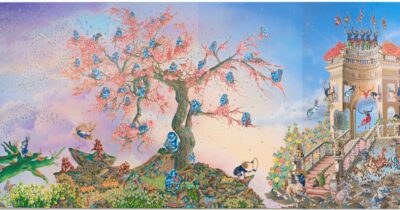
The biggest hit to artisans and painting tradition, however, was with technological advancement. The introduction of photography and camera removed the need for painters. Val Prinsep in 1877 writes about this abrupt decline, “It is a pity, that such wonderful dexterity should be thrown away.” Just like this millennia of old tradition of Royal Paintings died with the death of last Mughal ruler.
The Mughal style of miniature paintings that were prevalent in this period was later revived not by Royal courts but by nationalistic ambitions and rejection of Western cultures, including paintings. Several schools of art were established in Bengal and South India, that helped in institutionalising and promoting this culture to future generations. Even in North India the tradition survived on trade with tourists. Today, the world of Late Mughal style paintings are kept alive by museums and galleries and workshops that promote their education. Several modern artists have been inspired by that period for example Raqib Shaw.
Conclusion
The rich cultural heritage of Delhi have always been topic of discussion across societies. According to Emma Roberts a contemporary “There is no place in British India that the intellectual traveler approaches with feelings more strongly excited than the ancient seat of Mughal Empire.” This feeling of admiration for one’s tradition is clearly visible from the paintings of this period. The foreigners submerged in court culture and wanting to capture every moment of this country and the people in foreign lands curious with images of exotic life were the propagators of Late Mughal style paintings of Delhi residency. The awe-inspiring details, fabulous depth and alive nature still inspires scholars and artists alike. Still filling the viewers with appreciation that they were created with.
Reference
- Dalrymple, William & Sharma, Yuthika. Princes and Painters in Mughal Delhi, 1707–1857. Asia Society.
- Archer, Mildred. Artists and Patrons in Residency Delhi 1803–1858, in R.E. Frykenberg, ed., “Delhi Through the Age: Essays in Urban History, Culture and Society”. Oxford University Press.
- Kumar, Lily. Picturesque India: Revisiting Colonial Landscape Art. Niche–Canada.org.
- Nair, Eisha. Hidden Figures: Colonial Artists and Calcutta as a Muse. Sarmaya.in.




